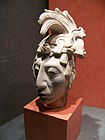This article is about the pre-Columbian Maya civilization. For a discussion of the modern Maya, see Maya peoples. For other meanings of the word Maya, see Maya.
 |
The Maya is a Mesoamerican civilization, noted for the only known fully developed written language of the pre-Columbian Americas, as well as for its art, architecture,
and mathematical and astronomical systems. Initially established during
the Pre-Classic period (c. 2000 BC to AD 250), according to the Mesoamerican chronology, many Maya cities
reached their highest state of development during the Classic period
(c. AD 250 to 900), and continued throughout the Post-Classic period
until the arrival of the Spanish.
The Maya civilization shares many features with other Mesoamerican civilizations due to the high degree of interaction and cultural diffusion that characterized the region. Advances such as writing, epigraphy, and the calendar did not originate with the Maya; however, their civilization fully developed them. Maya influence can be detected from Honduras, Guatemala, and western El Salvador to as far away as central Mexico, more than 1,000 km (620 mi) from the Maya area. Many outside influences are found in Maya art and architecture, which are thought to result from trade and cultural exchange rather than direct external conquest.
The Maya peoples never disappeared, neither at the time of the Classic period decline nor with the arrival of the Spanish conquistadores and the subsequent Spanish colonization of the Americas.
Today, the Maya and their descendants form sizable populations
throughout the Maya area and maintain a distinctive set of traditions
and beliefs that are the result of the merger of pre-Columbian and
post-Conquest ideas and cultures. Millions of people speak Mayan languages today; the Rabinal Achí, a play written in the Achi language, was declared a Masterpiece of the Oral and Intangible Heritage of Humanity by UNESCO in 2005.
-
Maya statue from Tonina AD 600-900
-
Jaina Island type figure AD 650-800






Hiç yorum yok:
Yorum Gönder